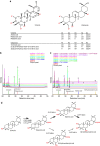The ancient CYP716 family is a major contributor to the diversification of eudicot triterpenoid biosynthesis
- PMID: 28165039
- PMCID: PMC5303825
- DOI: 10.1038/ncomms14153
The ancient CYP716 family is a major contributor to the diversification of eudicot triterpenoid biosynthesis
Abstract
Triterpenoids are widespread bioactive plant defence compounds with potential use as pharmaceuticals, pesticides and other high-value products. Enzymes belonging to the cytochrome P450 family have an essential role in creating the immense structural diversity of triterpenoids across the plant kingdom. However, for many triterpenoid oxidation reactions, the corresponding enzyme remains unknown. Here we characterize CYP716 enzymes from different medicinal plant species by heterologous expression in engineered yeasts and report ten hitherto unreported triterpenoid oxidation activities, including a cyclization reaction, leading to a triterpenoid lactone. Kingdom-wide phylogenetic analysis of over 400 CYP716s from over 200 plant species reveals details of their evolution and suggests that in eudicots the CYP716s evolved specifically towards triterpenoid biosynthesis. Our findings underscore the great potential of CYP716s as a source for generating triterpenoid structural diversity and expand the toolbox available for synthetic biology programmes for sustainable production of bioactive plant triterpenoids.
Conflict of interest statement
The authors declare no competing financial interests.
Figures




Similar articles
-
Functional Characterization of CYP716 Family P450 Enzymes in Triterpenoid Biosynthesis in Tomato.Front Plant Sci. 2017 Jan 30;8:21. doi: 10.3389/fpls.2017.00021. eCollection 2017. Front Plant Sci. 2017. PMID: 28194155 Free PMC article.
-
Cytochrome P450 Monooxygenase CYP716A141 is a Unique β-Amyrin C-16β Oxidase Involved in Triterpenoid Saponin Biosynthesis in Platycodon grandiflorus.Plant Cell Physiol. 2017 May 1;58(5):874-884. doi: 10.1093/pcp/pcx043. Plant Cell Physiol. 2017. PMID: 28371833
-
Engineering Critical Enzymes and Pathways for Improved Triterpenoid Biosynthesis in Yeast.ACS Synth Biol. 2020 Sep 18;9(9):2214-2227. doi: 10.1021/acssynbio.0c00124. Epub 2020 Aug 24. ACS Synth Biol. 2020. PMID: 32786348 Review.
-
P450s and UGTs: Key Players in the Structural Diversity of Triterpenoid Saponins.Plant Cell Physiol. 2015 Aug;56(8):1463-71. doi: 10.1093/pcp/pcv062. Epub 2015 May 6. Plant Cell Physiol. 2015. PMID: 25951908 Free PMC article. Review.
-
Oxidosqualene cyclase and CYP716 enzymes contribute to triterpene structural diversity in the medicinal tree banaba.New Phytol. 2019 Apr;222(1):408-424. doi: 10.1111/nph.15606. Epub 2018 Dec 20. New Phytol. 2019. PMID: 30472753
Cited by
-
Cytochrome P450 monooxygenase-mediated tailoring of triterpenoids and steroids in plants.Beilstein J Org Chem. 2022 Sep 21;18:1289-1310. doi: 10.3762/bjoc.18.135. eCollection 2022. Beilstein J Org Chem. 2022. PMID: 36225725 Free PMC article. Review.
-
Boosting the biosynthesis of betulinic acid and related triterpenoids in Yarrowia lipolytica via multimodular metabolic engineering.Microb Cell Fact. 2019 May 3;18(1):77. doi: 10.1186/s12934-019-1127-8. Microb Cell Fact. 2019. PMID: 31053076 Free PMC article.
-
Differential Expression of Genes Involved in Saikosaponin Biosynthesis Between Bupleurum chinense DC. and Bupleurum scorzonerifolium Willd.Front Genet. 2020 Oct 16;11:583245. doi: 10.3389/fgene.2020.583245. eCollection 2020. Front Genet. 2020. PMID: 33193712 Free PMC article.
-
Representational Difference Analysis of Transcripts Involved in Jervine Biosynthesis.Life (Basel). 2020 Jun 19;10(6):88. doi: 10.3390/life10060088. Life (Basel). 2020. PMID: 32575579 Free PMC article.
-
Comparative proteome and metabolome analyses of latex-exuding and non-exuding Taraxacum koksaghyz roots provide insights into laticifer biology.J Exp Bot. 2020 Feb 19;71(4):1278-1293. doi: 10.1093/jxb/erz512. J Exp Bot. 2020. PMID: 31740929 Free PMC article.
References
-
- Thimmappa R., Geisler K., Louveau T., O'Maille P. & Osbourn A. Triterpene biosynthesis in plants. Annu. Rev. Plant Biol. 65, 225–257 (2014). - PubMed
-
- Vincken J. P., Heng L., de Groot A. & Gruppen H. Saponins, classification and occurrence in the plant kingdom. Phytochemistry 68, 275–297 (2007). - PubMed
-
- Moses T., Pollier J., Thevelein J. M. & Goossens A. Bioengineering of plant (tri)terpenoids: from metabolic engineering of plants to synthetic biology in vivo and in vitro. New Phytol. 200, 27–43 (2013). - PubMed
Publication types
MeSH terms
Substances
LinkOut - more resources
Full Text Sources
Other Literature Sources
Research Materials

